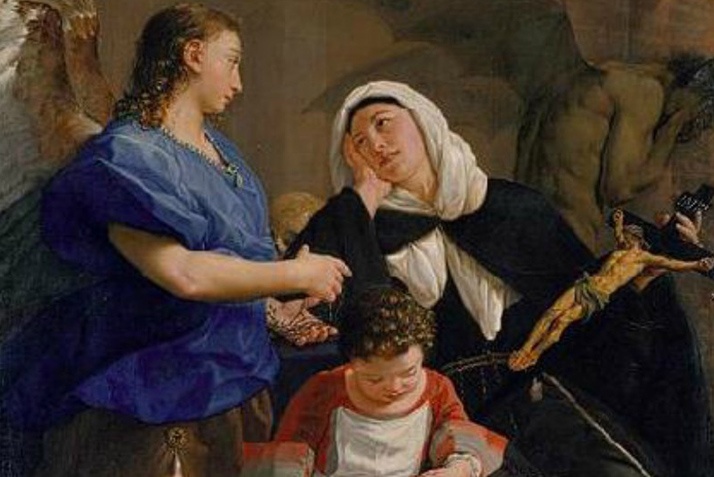Copyright Image St. Margaret of Cortona by Medan [Public domain or Public domain], via Wikimedia Commons

By: Guest blogger on November 22nd, 2017
Mommy Saints
I love reading the biographies of saints. In their stories I always find lessons, aspirations, and encouragement, no matter their vocation in life. After all, we all have the same goal, even if we achieve it in different ways. Still, I can relate to women who have experienced some of the same duties and trials in which I find myself embroiled.
The Church holds up for our edification some beautiful, holy mothers: St. Monica, St. Rita, St. Gianna Mola, and St. Zelie Martin. It seems Elizabeths make for holy mommies: St. Elizabeth of Hungary, St. Elizabeth of Portugal, and St. Elizabeth, mother of St. John the Baptist. Of course, the greatest of all mothers is our Blessed Mother Mary.
During this month of holy souls and holy saints, I wish to present to you three mommy saints with whom you may not be acquainted. May you find in their stories lessons, aspiration and encouragement.
St. Eliza Vaughan
Born into a wealthy English protestant family, Eliza Rolls (of Rolls-Royce fame) was educated in France. There she was impressed by the Catholic Church’s mission to the poor. But not until she married Col. John Francis Vaughan did she convert to the Catholic faith, despite strong objections from her family.
The Colonel’s family had a strong Catholic faith that dated back to the persecutions under Queen Elizabeth I’s reign (1558-1603). During that time the Vaughan family home was a place of refuge for priests where Mass was secretly celebrated.
Upon reading a book given to her by John’s aunt about St. Bernard of Clairvaux’s mother, Eliza began to pray in earnest for a large family and lots of vocations. She spent an hour a day in the family’s chapel praying for these intentions. Her prayers were answered.
John and Eliza had 14 children. Thirteen lived into adult years. Of her eight sons, six became priests. Of those six, one became a bishop, another an archbishop, and her oldest son became a cardinal. Not to be outdone, four of her five daughters became nuns.
Along with specifically praying for vocations, Eliza and her children attended daily Mass, said prayers together, and performed acts of charity. In order to inspire them, she read the lives of the saints to her children.
St. Eliza Vaughan shows us how to foster vocations in our own families. She teaches us that holiness can be contagious!
St. Gladys
St. Gladys’ story makes clear that it goes both ways — just as holiness can be contagious, so can wickedness. The eldest daughter of King Brychan of Wales in the 6th century, Gladys was wooed by a robber chieftain known as Woolos. When he was refused her hand in marriage, Woolos gathered 300 of his men and kidnapped Gladys. Content to have a warrior husband, Gladys lived life on the run. Their life was violent as they conducted raids and piracy together.
Once, they stole the only cow of the sainted monk Tatheus. In reparation, they gave the care of their first son, Cadoc, to St. Tatheus. Cadoc, under the guidance of this holy man of God, began to understand the errors of his family’s ways. He prayed for their conversion.
Gladys was the first to come back to the Faith into which she was baptized. Eventually, her husband and other children repented, too. Woolos and Gladys stopped their looting ways and began building monasteries and churches, performed works of charity among their people, and kept the peace in their little kingdom. They became good and just monarchs.
After several years of peaceful rule, Woolos gave up his kingship and moved Cadoc’s abbey. Gladys, likewise, moved to a hermitage nearby. They lived the rest of their days in acts of penance and prayer.
St. Gladys gives us an example of mutual sanctification. Husbands and wives ought to work together to help each other and their children become holy. Her story also reveals to us that our children can play a part in our growth in holiness.
St. Margaret of Cortona
It is well and good that husbands and wives guide each other and their children on the journey towards heaven. But as it is, sometimes sin enters into our story, be it original sin which caused death to come into the world or actual sin which we ourselves commit. Then moms have to raise children on their own. This takes extraordinary grace.
St. Margaret of Cortona was a single mom.
Born the only child of a hard-working couple, Margaret was very beautiful, terribly spoiled, and quite willful. As she grew older, men took notice of her. When she was a teen, her mom died. Margaret lost the only influence that held her in check. By the age of 17, she had a reputation in town.
The nobleman for whom she work became attracted to her independant spirit and beauty. They fell in love. The conventions of the day, however, prevented him from marrying her, though he promised that one day he would. That day never came. Not even when she bore him a son.
When her child was born, Margaret began to settle down. Her conscience revived in her, and she realized that she had not been living a life of freedom. On the contrary, she was enslaved and did not know how to get out of lifestyle she was living.
After nine years, when her lover was found murdered and half buried in the woods, Margaret found the courage and the humility to walk to her father’s house to beg forgiveness. Aware that her sin was known to all, Margaret performed a public confession and penance. Still, the shame and embarrassment was too much for her father. At the bidding of Margaret’s stepmother, he turned her out.
She traveled with her son to Cortona in search of a new beginning and to get away from old miseries. In order to support herself and her son, she became a nurse and midwife. She accepted as payment whatever was offered to her. Moreover, she gave half of what she earned to those in need. Eventually, she founded a hospital for the poor. In time, she became a third-order (secular) Franciscan.
Throughout the rest of her life, St. Margaret perform acts of penance in reparation for her sins past, to root out old cravings, and for love of her Lord. More than anything, she desired to grow closer to God. In the end, Margaret experienced True Love.
Shortly before her death, St. Margaret of Cortona had a vision of Jesus and St. Mary Magdalene. Looking at Margaret, Jesus said to Mary, “This is my beloved daughter.” St. Margaret died in peace.
St. Margaret’s story confirms our desire for true love. Furthermore, it teaches us that even when those around us fail us in love, there is always One who loves us perfectly. For Him, we ought to live.
You
So, ladies, let us keep in mind that being a mommy is no easy job! And there is no one way to accomplish this task entrusted to us by God. We pray; we make sacrifices, we do our best. Then we trust God to do the rest. Each of us has own our path but the same destination. Therefore, no matter what, let us encourage one another on the way.
“I am confident of this very thing: that He who has begun this good work in you will perfect it, unto the day of Christ Jesus” (Phil. 1:6)
Copyright 2017 Kelly Guest
This article was originally published at CatholicMom.comand is shared here with permission.
